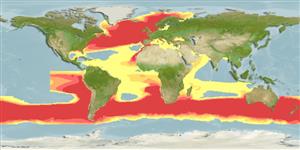Elasmobranchii (tubarões e raias) (sharks and rays) >
Lamniformes (Mackerel sharks) >
Lamnidae (Mackerel sharks or white shark)
Etymology: Lamna: From the Greek lamia, a large and voracious shark, originally from Lamia in Greek mythology, daughter of King Belos, who revenged the murder of her children by killing the children of others, and who behaved so cruelly that her face turned into a nightmarish mask. (See ETYFish); nasus: Latin for nose, referring to moderately long conical snout. (See ETYFish).
More on author: Bonnaterre.
Environment: milieu / climate zone / depth range / distribution range
Ecologia
marinhas; oceanódromo (Ref. 51243); intervalo de profundidade 0 - 1360 m (Ref. 114967), usually 0 - 300 m (Ref. 119696). Boreal; -1°C - 23°C (Ref. 98315); 76°N - 59°S, 180°W - 180°E (Ref. 247)
Circumglobal, amphitemperature with centers of distribution in the North Atlantic and temperate water of the southern hemisphere; not in equatorial seas.
Comprimento de primeira maturação / Tamanho / Peso / Idade
Maturity: Lm 186.5, range 170 - 219 cm
Max length : 350 cm TL macho/indeterminado; (Ref. 4645); common length : 244 cm TL macho/indeterminado; (Ref. 5951); peso máx. publicado: 230.0 kg (Ref. 40637); idade máx. registrada: 65 anos (Ref. 119696)
Espinhos dorsais (total) : 0; Espinhos anais: 0. A stout, spindle-shaped shark with large black eyes, a sharp, conical snout, long gill slits, and small, smooth-edged, narrow teeth with side cusps (Ref. 5578, 88171). Strong keels on the caudal peduncle, short secondary keels on the caudal base, and a crescentic caudal fin; the insertion of the small second dorsal fin is above the insertion of the anal fin (Ref. 88171). Dark grey dorsally, white ventrally, without blotches (Ref. 6581, 43278); rear tip of 1st dorsal abruptly white (Ref. 5578).
Occurs inshore to offshore fishing banks and occasionally to open ocean areas. It is migratory, moves generally along the continental shelves (inshore to surface during simmer) and winters offshore in deeper water (Ref. 58085). Most abundant on continental offshore fishing banks but also found far from land in ocean basins and occasionally close inshore (Ref. 247). Extreme depth reported to 1,360 meters. Age attained in North Atlantic at least 26 years and in the Southern Hemisphere probably 65 years (Ref. 119696). Specimens tagged off southern England were recaptured in northern Norway (having travelled 2,370 km), Denmark and Spain (Ref. 88752, 88753). The northwest Atlantic stock migrates from Newfoundland, Canada in the winter to Massachusetts in the summer (Ref. 43278, 88754). Trans-Atlantic migrations have also been recorded. One of the most cold-tolerant sharks; in the northwest Atlantic mostly found from 5-10°C (Ref. 88755); with extremes of -1°C and 23°C (Ref. 119696). Known to temporarily tolerate salinities as low as 10 to follow its prey (Ref. 88740). Found singly and in schools and feeding aggregations (Ref. 247). Feeds on small and medium-sized pelagic schooling species, other sharks, squid (Ref. 5578) and demersal fishes (cod, white hake, red hake, haddock and cusk (Ref. 5951, 43278)). Ovoviviparous species (Ref. 43278, 50449). Females grow larger than males (Ref. 88756). Parasites include Phyllobothrium dagnallium (found in stomach, intestine and spiral valve) and Dinobothrium sp. (Ref. 5951). Regarded as potentially dangerous to people because of its size and activity but has never or very seldom been indicted in an attack on people or boats (Ref. 247). Considered by some as a sport fish (Ref. 84357). The flesh of the porbeagle is of good quality and texture and is said to taste like swordfish (Ref. 84357). Utilized fresh, dried or salted and frozen for human consumption; for oil and fishmeal; fins for shark-fin soup (Ref. 247). May be pan-fried and broiled (Ref. 9988). Catch records and studies in the northeast Atlantic show segregation by sex and size (Ref. 56108, 88756, 88757).
Distinct pairing with embrace (Ref. 205). Ovoviviparous (aplacental viviparity), with uterine cannibalism (embryos feeding on other ova produced by the mother (oophagy) after the yolk sac is absorbed) (Ref. 43278, 50449). With 1-5 (usually 4) pups in a litter (Ref. 6871, 43278). Reproduction probably yearly (Ref. 45602). In the northeast Atlantic, breeding grounds are off the coast of Europe and the British Isles. Embryos found in mature females throughout the year except from July to September. Mating occurs in late summer, pups are born in the spring of the following year (Ref. 43278). Gestation may last 8-9 months. Size at birth 60-80 cm TL (Ref. 6871, 43278).
Compagno, L.J.V., 1984. FAO Species Catalogue. Vol. 4. Sharks of the world. An annotated and illustrated catalogue of shark species known to date. Part 1 - Hexanchiformes to Lamniformes. FAO Fish. Synop. 125(4/1):1-249. Rome, FAO. (Ref. 247)
Status na Lista Vermelha da UICN (Ref. 130435)
Ameaça para os humanos
Traumatogenic (Ref. 4690)
Uso pelos humanos
Pescarias: espécies comerciais; peixe esportivo: sim
Ferramentas
Relatórios especiais
Baixar XML
Fontes da internet
Estimates based on models
Preferred temperature (Ref.
123201): 3.1 - 16.3, mean 7.8 °C (based on 1486 cells).
Índice de diversidade filogenética (Ref.
82804): PD
50 = 0.7813 [Uniqueness, from 0.5 = low to 2.0 = high].
Bayesian length-weight: a=0.01047 (0.00604 - 0.01816), b=3.03 (2.87 - 3.19), in cm total length, based on LWR estimates for this species & (Sub)family-body (Ref.
93245).
Nível Trófico (Ref.
69278): 4.6 ±0.0 se; based on diet studies.
Generation time: 9.5 ( na - na) years. Estimated as median ln(3)/K based on 1
growth studies.
Resiliência (Ref.
120179): Muito baixo(a), tempo mínimo de duplicação da população maior que 14 anos (K=0.12; tm=5; tmax=30; Fec=1-5).
Prior r = 0.05, 95% CL = 0.03 - 0.07, Based on 3 full stock assessments.
Fishing Vulnerability (Ref.
59153): High to very high vulnerability (74 of 100).
Climate Vulnerability (Ref.
125649): High vulnerability (62 of 100).
Nutrients (Ref.
124155): Calcium = 2.77 [0.73, 15.82] mg/100g; Iron = 0.301 [0.075, 1.026] mg/100g; Protein = 19.2 [16.9, 21.6] %; Omega3 = 0.387 [0.159, 0.924] g/100g; Selenium = 16 [5, 47] μg/100g; VitaminA = 6.86 [1.47, 34.61] μg/100g; Zinc = 0.202 [0.100, 0.381] mg/100g (wet weight); based on
nutrient studies.
